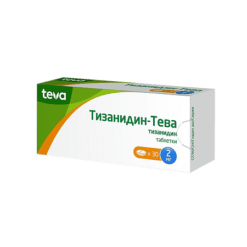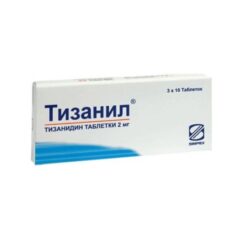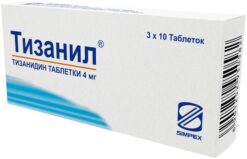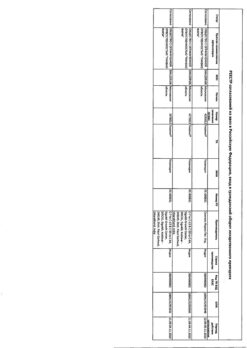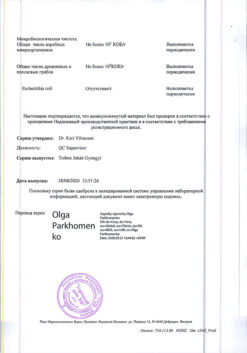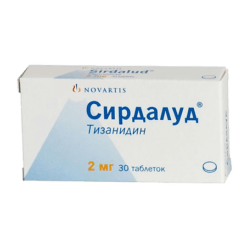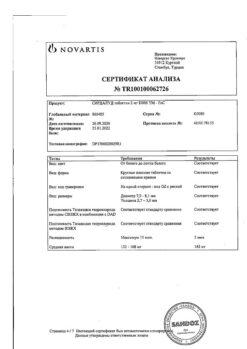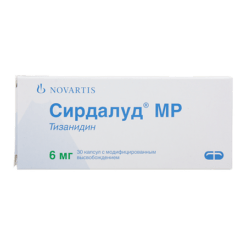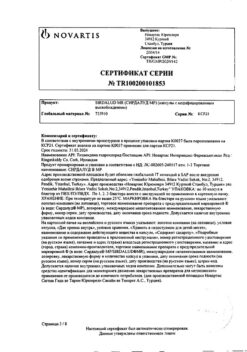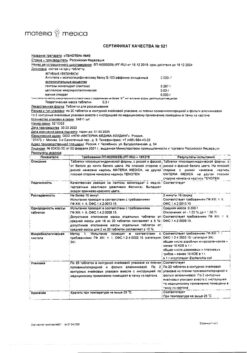No products in the cart.
Tizanidine, tablets 4 mg 30 pcs
€7.85 €6.87
Description
Pharmacotherapeutic group: Myorelaxant of central action
ATC code: M03BX
Pharmacodynamics:
Indications
Indications
Painful muscle spasm:
associated with static and functional diseases of the spine (cervical and lumbar syndrome)
after surgery, for example for a herniated disc or osteoarthritis of the hip joint.
Spasticity of skeletal muscles in neurological diseases – multiple sclerosis, chronic myelopathy, degenerative diseases of the spinal cord, consequences of cerebrovascular accidents, cerebral palsy (in patients over 18 years of age).
Pharmacological effect
Pharmacological effect
Pharmacotherapeutic group: Centrally acting muscle relaxant
ATX code: M03BX
Pharmacodynamics:
Special instructions
Special instructions
Hypotension may occur during the use of tizanidine and also as a result of drug interactions with inhibitors of the CYP1A2 isoenzyme and/or antihypertensive drugs. A marked decrease in blood pressure can lead to loss of consciousness and circulatory collapse.
Cases of liver dysfunction associated with tizanidine have been reported; however, these cases were rare when using daily doses of up to 12 mg. In this regard, it is recommended to monitor liver function tests once a month in the first 4 months of treatment in those patients who are prescribed tizanidine at a daily dose of 12 mg or higher, as well as in cases where there are clinical signs suggesting impaired liver function, such as unexplained nausea, anorexia, fatigue. In cases where serum ALT and AST levels consistently exceed the upper limit of normal by 3 times or more, the use of the drug should be discontinued.
During treatment you should refrain from drinking alcohol.
Due to the threat of withdrawal syndrome, the dose of the drug is reduced gradually.
Patients with preserved reproductive potential should be informed about the adverse effects of the drug on the developing fetus identified in animal studies. During treatment and for 1 day after stopping tizanidine, patients with preserved reproductive potential should use reliable methods of contraception.
Impact on the ability to drive vehicles. Wed and fur.:
Due to the profile of adverse reactions, it is recommended to refrain from activities that require a high concentration of attention and quick reactions, such as driving vehicles or working with machines and mechanisms.
Active ingredient
Active ingredient
Tizanidine
Composition
Composition
For one tablet:
Active ingredient:
tizanidine hydrochloride – 4.576 mg, in terms of tizanidine – 4.000 mg.
Excipients:
lactose monohydrate (milk sugar) – 100,000 mg,
microcrystalline cellulose – 90.624 mg,
stearic acid – 3,800 mg,
colloidal silicon dioxide – 1,000 mg.
Pregnancy
Pregnancy
Pregnancy
Since no controlled studies have been conducted on the use of tizanidine in pregnant women, it should not be used during pregnancy unless the potential benefit to the mother outweighs the possible risk to the fetus.
No teratogenicity was detected in animal studies. When used in doses of 10 and 30 mg/kg per day in animals, an increase in gestational age was observed; cases of prenatal and postnatal fetal loss, as well as delayed fetal development, were recorded. When using the above doses, females showed pronounced signs of muscle relaxation and sedation.
Before starting the use of Tizanidine in patients with preserved reproductive potential, it is recommended to conduct a pregnancy test.
In animal studies, no adverse effects on male or female fertility were observed with tizanidine at doses of 10 mg/kg per day and 3 mg/kg/day, respectively. There was a decrease in fertility in males receiving tizanidine at a dose exceeding 30 mg/kg per day and in females at a dose exceeding 10 mg/kg per day. Based on body surface area, these doses exceeded the maximum recommended dose for humans (072 mg/kg per day) by 22 and 67 times.
Breast-feeding
During treatment with tizanidine, breastfeeding should be stopped as there is no data on the penetration of the drug into breast milk. In animal studies, tizanidine was excreted in small amounts in the milk of lactating females.
Contraindications
Contraindications
– Hypersensitivity to tizanidine or any other component of the drug;
– severe liver dysfunction;
– simultaneous use with powerful inhibitors of the CYP1A2 isoenzyme (fluvoxamine and ciprofloxacin);
– pregnancy;
– breastfeeding period;
– children under 18 years of age (efficacy and safety have not been established).
– it is not recommended to use the drug in patients with rare hereditary galactose intolerance and lactase deficiency (glucose-galactose malabsorption) since the drug contains lactose.
With caution:
It is recommended to exercise caution when using tizanidine in patients with moderately severe liver dysfunction (congenital long Q-T interval syndrome), as well as when used simultaneously with drugs that prolong the Q-T interval, as well as in patients over the age of 65 years. It is necessary to regularly monitor laboratory indicators of the functional state of the heart and monitor ECG indicators.
Side Effects
Side Effects
When using small doses recommended for relieving painful muscle spasms, drowsiness, increased fatigue, dizziness, dry mouth, decreased blood pressure, nausea, gastrointestinal disorders, increased activity of liver transaminases were observed. Typically, the above adverse reactions are moderate and transient.
When taking higher doses recommended for the treatment of spasticity, the above-described adverse reactions occur more often and are more pronounced, but do not require discontinuation of the drug. In addition, the following phenomena were observed when using tizanidine: bradycardia, muscle weakness, insomnia, sleep disturbance, hallucinations, hepatitis.
The frequency of the side effects listed below was determined according to the following (World Health Organization classification): very often (more than 10%); often (more than 1% and less than 10%); infrequently (more than 01% and less than 1%); rarely (more than 001% and less than 01%); very rarely (less than 001%) including individual messages; frequency unknown (cannot be estimated from available data).
From the nervous system: very often – drowsiness, dizziness.
From the mental side: often – insomnia, sleep disturbances.
From the cardiovascular system: often – a decrease in blood pressure (in some cases, expressed up to collapse and loss of consciousness); infrequently – bradycardia.
From the digestive system: very often – dry mouth, gastrointestinal disorders; often – nausea.
Laboratory indicators: often – increased activity of microsomal liver enzymes.
From the musculoskeletal system: very often – muscle weakness.
General disorders: very often – increased fatigue, “withdrawal” syndrome.
With abrupt discontinuation of tizanidine after prolonged treatment and/or taking high doses of the drug (as well as after simultaneous use with antihypertensive drugs), the development of tachycardia and an increase in blood pressure was observed, which in some cases could lead to acute cerebrovascular accident; therefore, the dose of the drug should be reduced gradually until the drug is completely discontinued.
Selected reports of adverse events based on clinical use:
During tizanidine therapy, the following adverse events were observed in clinical practice without indication of a cause-and-effect relationship with the use of the drug (the frequency of adverse events has not been established).
From the psyche: frequency unknown – hallucinations, confusion.
From the nervous system: frequency unknown – vertigo.
On the part of the organ of vision: frequency unknown – blurred vision.
From the liver and biliary tract: frequency unknown – hepatitis, liver failure.
From the immune system: frequency unknown – hypersensitivity reactions including anaphylactic reactions, angioedema and urticaria.
From the skin and subcutaneous tissue: frequency unknown – skin rash, erythema, itching, dermatitis.
General disorders: frequency unknown – asthenia withdrawal syndrome.
With abrupt withdrawal of tizanidine, cases of rebound hypertension and tachycardia were noted; in some cases, a rebound increase in blood pressure led to acute cerebrovascular accident.
If any of the side effects indicated in the instructions get worse or you notice any other side effects not listed in the instructions, tell your doctor.
Interaction
Interaction
With the simultaneous use of tizanidine and:
– inhibitors of the CYP1A2 isoenzyme may increase the concentration of tizanidine in the blood plasma. In turn, an increase in the concentration of tizanidine in plasma can lead to symptoms of drug overdose, including. prolongation of the QT(c) interval.
– inducers of the CYP1A2 isoenzyme can lead to a decrease in plasma levels of tizanidine. Reduced plasma levels of tizanidine may lead to a decrease in the therapeutic effect of the drug.
Tizanidine combinations are contraindicated
The simultaneous use of tizanidine with fluvoxamine or ciprofloxacin, which are inhibitors of the CYP1A2 isoenzyme, is contraindicated.
When tizanidine was used with fluvoxamine or ciprofloxacin, a 33-fold and 10-fold increase in tizanidine AUC was observed, respectively. The result of combined use may be a clinically significant and prolonged decrease in blood pressure, accompanied by drowsiness, dizziness, and a decrease in the speed of psychomotor reactions (in some cases, up to collapse and loss of consciousness).
Tizanidine Combinations Not Recommended
It is not recommended to prescribe tizanidine together with other inhibitors of the CYP1A2 isoenzyme – antiarrhythmic drugs (amiodarone mexiletine propafenone) cimetidine some fluoroquinolones (enoxacin pefloxacin norfloxacin) rofecoxib oral contraceptives ticlopidine.
Combinations with tizanidine requiring caution
Caution should be exercised when co-administering tizanidine with drugs that prolong the QT interval (for example, cisapride, amitriptyline, azithromycin).
Antihypertensive drugs
The simultaneous administration of tizanidine with antihypertensive drugs, including diuretics, can sometimes cause a pronounced decrease in blood pressure (in some cases, even collapse and loss of consciousness) and bradycardia.
When tizanidine was abruptly discontinued after use together with antihypertensive drugs, the development of tachycardia and an increase in blood pressure in some cases could lead to acute cerebrovascular accident.
Rifampicin
Simultaneous administration of tizanidine and rifampicin leads to a 50% decrease in the concentration of tizanidine in blood plasma. As a result, the therapeutic effect of tizanidine may be reduced, which may be of clinical significance for some patients. Long-term combined use of rifampicin and tizanidine should be avoided; if this is not possible, careful selection of the dose of tizanidine (increase) is recommended.
Smoking
The systemic bioavailability of tizanidine in men who smoke (more than 10 cigarettes per day) is reduced by approximately 30%. Long-term tizanidine therapy in men who smoke may require higher than average therapeutic doses.
Ethanol
During tizanidine therapy, alcohol intake should be avoided because it may increase the likelihood of adverse effects (eg low blood pressure and lethargy). Tizanidine may enhance the suppressive effects of ethanol on the central nervous system.
Other medicines
Sedative hypnotics (benzodiazepine baclofen) and other drugs such as antihistamines may also increase the sedative effect of tizanidine. Avoid taking tizanidine with other alpha2-agonists (eg clonidine) due to the potential for increased hypotensive effects.
Interaction with food: see section “Pharmacokinetics”.
Overdose
Overdose
To date, there have been cases of tizanidine overdose, including a case where the dose taken was 400 mg. In all cases, recovery was uneventful.
Symptoms:
Nausea, vomiting, marked decrease in blood pressure, prolongation of the QT(c) interval, dizziness, drowsiness, miosis, anxiety, respiratory failure, coma.
Treatment:
To remove tizanidine from the body, gastric lavage, repeated administration of activated charcoal, and intake of large amounts of liquid are recommended. Carrying out forced diuresis may also speed up the elimination of tizanidine. Subsequently, symptomatic treatment is carried out.
Storage conditions
Storage conditions
At a temperature not exceeding 25 °C.
Keep out of the reach of children.
Shelf life
Shelf life
3 years.
Do not use the drug after the expiration date.
Manufacturer
Manufacturer
Ozon, Russia
Additional information
| Shelf life | 3 years. Do not use after the expiration date. |
|---|---|
| Conditions of storage | At a temperature not exceeding 25 ° C. Store out of the reach of children. |
| Manufacturer | Ozon, Russia |
| Medication form | pills |
| Brand | Ozon |
Other forms…
Related products
Buy Tizanidine, tablets 4 mg 30 pcs with delivery to USA, UK, Europe and over 120 other countries.


